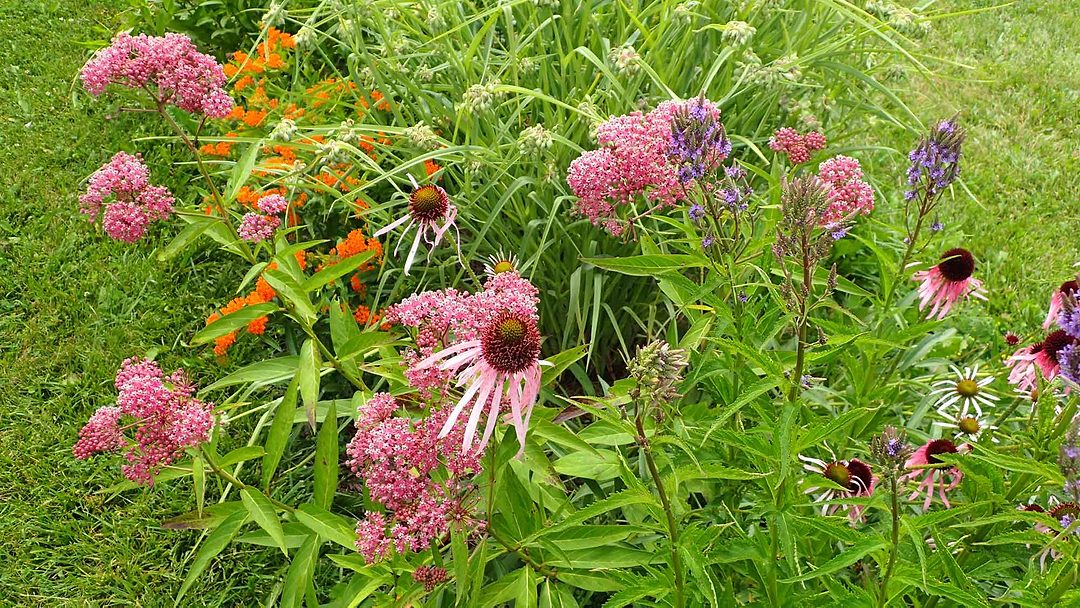Every backyard has a unique variety of flowers, trees, and the occasional persistent weed. The importance of our yard vegetation often falls under the radar, especially in grass lawn-dominated suburbia and a society that prizes outdoor aesthetics with little thought to the ecological value a landscape can provide. Casual and dedicated gardeners alike frequently purchase plants for how pretty their flowers look or because their leaves are evergreen. Emphasizing these qualities, while not insignificant, often means we overlook whether or not a plant will contribute to the health of the surrounding ecosystem—for example, will it support pollinators and the critical ecological role they play? Answering this question will help us understand how to combat the grass lawn standard and instead, create pollinator gardens that provide vital habitat for local pollination systems and improve the ecological health of the surrounding landscape.
Grow Native Massachusetts is a nonprofit organization dedicated to inspiring people to action on behalf of native plants and the diversity of life they support - including pollinators. Grow Native explains that pollinators are “bees, butterflies, hummingbirds, moths, wasps, flies, beetles, and even a few bats … that move pollen between flowers,” and are essential to the reproductive system of plants across global ecosystems. According to the U.S. Forest Service, without them, the world would not have 80% of its flowering plants—a loss that would be catastrophic. The populations of many species of valuable insect pollinators, such as bumblebees, have been in significant decline in Massachusetts (and across the country) for decades. The decline of pollinators underpins the need to provide vital habitat for native pollinators and to strengthen the local pollination systems.
Understanding the important role native plants play is a key factor in creating a pollinator garden. Grow Native describes native plants as “in a word, local. They are plants that have been growing in a particular habitat and region, typically for thousands of years or much longer. Also called indigenous, they are well adapted to the climate, light, and soil conditions that characterize their ecosystem. Within this system, they have evolved tremendously important co-evolutionary relationships with the other plants, animals, fungi, and bacteria present, and these very complex relationships keep that particular ecosystem stable.” These types of plants form the foundation for a healthy pollinator garden due to the co-evolutionary relationships they have with native pollinators and other insects.

Rudbeckia
Some native bees and wasps, for example, have specialized relationships with certain plant families, and need the pollen or nectar from those plants in order to reproduce. Specialization is also common among other valuable insects like caterpillars. As a result, a garden composed of a diversity of native plants will provide food and habitat to a diverse array of pollinators and other types of wildlife, and have a truly significant impact on the ecological health of the surrounding area.
In order to start building a pollinator garden, several initial steps must be taken. First, it is crucial to evaluate what plants already exist in your backyard. Often, weeds and invasive plants will dominate a garden space if uncontrolled. Identifying which plants are which can help with preparing the yard space for planting. For instance, some so-called weeds are, in fact, valuable. Species like milkweeds, evening primrose, fleabane, and goldenrods are a few examples of “weeds” that can be beneficial to an ecosystem. Namely, milkweeds (Asclepias spp.) are the only plants that host monarch butterflies, and fleabanes (Erigeron spp.) are valuable to a wide array of pollinators. In addition to evaluating the current state of an untouched garden plot, it can also be beneficial to understand the health of the soil.

New England Aster
In addition to soil health, knowing how much weed pressure exists in the area will help to create a longer lasting and more functional planting, particularly when working in a previously overgrown or “reclaimed” site. Keeping aggressive or invasive non-native plants from gaining a foothold on the site is key to making sure native plantings have a chance to establish.

Goldenrod
Another thing to take into consideration when selecting plants is having a mix of different flower shapes so that many types of pollinators will be able to feed on them. For instance, a hummingbird’s long tongue evolved to extract nectar from long tubular flowers, while many bee species have shorter proboscises and need shallower, open-faced flowers. In addition, make sure to include flower species that bloom at different times, so that pollinators will have access to food throughout the spring, summer, and fall. Indeed, although all gardens with flowers can be considered pollinator gardens, those created with carefully selected native plants are the better choice for sustaining biodiversity and supporting ecological systems.
Clearly, building a pollinator garden is a process and does not occur in one go. Understanding the current state of your untouched garden, and the vital factors of soil health, weed pressure, nutrient levels, and nectar availability, take time to consider. But no matter where you are in your pollinator garden journey, as you add native plants you will notice more beautiful wildlife as well. Planting native plants in a pollinator garden provides vital food and habitat for native pollinators, as well as resources to strengthen the local pollination systems. As you create a landscape that lasts, native insects, birds, and small mammals will begin to use the resources you provide. It is a process, but an incredibly satisfying one that will provide enjoyment for years to come, create functioning ecosystems, and establish a sense of place in any area. To learn more about native plants and how to attract pollinators to your garden, visit the Grow Native Massachusetts website at grownativemass.org.
Photos courtesy of Grow Native Massachusetts

